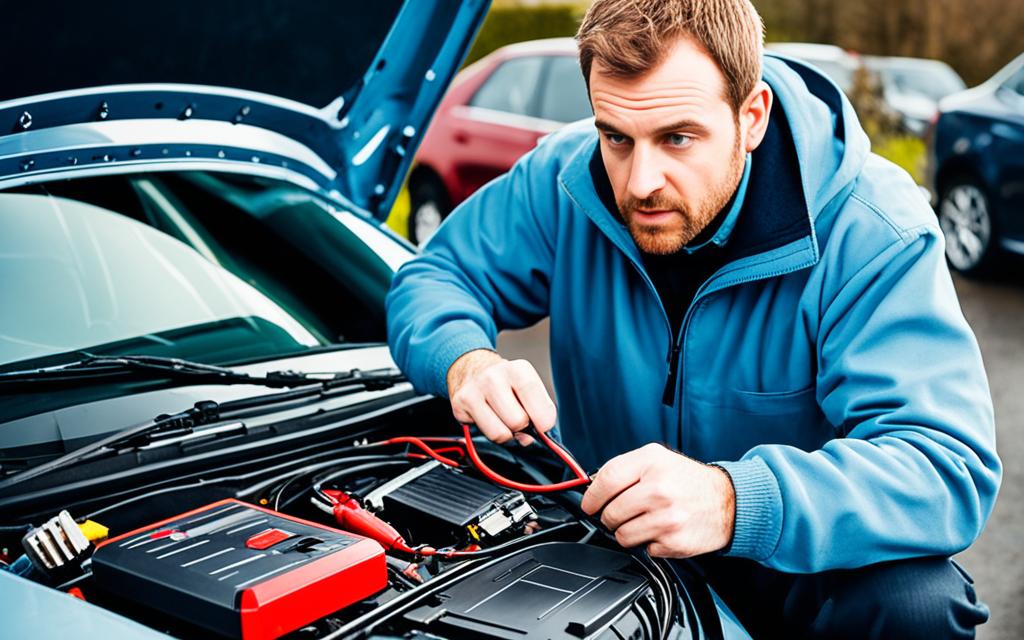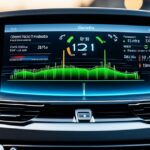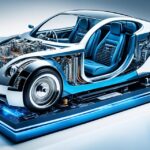Jump-starting a car can harm its electronics if not done right. Modern cars have complex electronic systems that are sensitive to voltage changes and improper handling during jump starts. If you jump-start a car wrongly, it could damage the electrical system, affecting the electronic control module and starter system. This could lead to expensive repairs1.
Connecting jumper leads wrongly or with the wrong polarity can also damage the car’s Electronic Control Unit (ECU) and cause it to fail2. It’s vital to connect the jumper leads correctly by linking positive to positive and negative to negative to avoid ECU damage2. Even though cars have overvoltage protection, damage can happen before the fuse blows. So, it’s crucial to jump-start correctly to avoid harm2.
Jump-starting can also affect other cars. Reversing the jumper cables can badly damage both cars3. This mistake often leads to damage3. Voltage surges during jump-starting can also harm low voltage parts in newer cars, affecting the battery system and the Engine Control Module (ECM) or Powertrain Control Module (PCM)3. To reduce the risk of damage, always follow the right procedures and take precautions when jump-starting a car3.
Key Takeaways:
- Incorrect jump-starting methods can damage a car’s electronics, like the Electronic Control Module (ECM) and starter system1.
- Short-circuiting jumper leads or connecting them wrongly can cause ECU failure2.
- Reversing jumper cables can severely damage both cars3.
- Voltage spikes during jump-starting can damage low voltage components, affecting newer cars’ battery systems and ECM/PCM3.
- Following the right jump-starting steps and precautions can lower the risk of damaging car electronics3.
Understanding the Risks of Jump Starting
Jump starting a car can seem like a quick fix when the battery dies, but it comes with risks, especially for car electronics. Modern cars have many electronic systems that can be damaged by jump starting. This can lead to expensive repairs4.
Jump starting can cause power spikes that affect car electronics. These spikes can harm the on-board computers in cars5. Sometimes, this damage can be permanent and very costly to fix4. To reduce this risk, some jumpers use diodes to stop power spikes from flowing back and forth between cars5.
Another risk is misconnecting the jumper cables. This mistake can damage expensive parts in the car, including electronics5. Cars with features like Start/Stop technology are especially vulnerable to power surges4.
Modern cars have expensive electronics that can be damaged by jump starting. Fixing these can cost between $4,000 to $5,0005. To avoid this, it’s better to use a jump start pack from a trunk. These packs are safer and cost about $505.
It’s important to keep jump start packs charged every 6 months to ensure they work well5. The condition of the batteries, correct cable connection, and the state of the jumping car also matter for safety5.
| Jump Starting Risks | Statistical Data |
|---|---|
| Power spikes can cause problems with on-board computers | 5 |
| Misconnecting jumper cables can lead to damage to expensive components | 5 |
| Concerns about damaging expensive electronics in modern cars | 5 |
| Jump-starting a car with advanced electronic features | 4 |
Understanding the risks of jump starting is key to protecting your car’s electronics. By following the right steps and using a jump start pack, you can avoid expensive repairs54.
For more information, check out these forums or this guide. The NRMA website also has useful info on jump-starting and its risks6.
Can Jump Starting Cause Electrical Problems?
Jump starting a car can lead to electrical issues if not done right. It involves connecting a working vehicle’s battery to a dead one to start the engine. But, if done incorrectly, it can harm the car’s electronics, causing expensive repairs.
Improper jump starting can lead to permanent damage and high repair costs4. Modern cars with advanced electronics are at risk during jump starts4. Power spikes at start-up can affect onboard computers, especially in newer cars5. The alternator and onboard computers can get damaged by improper jump starting4. A faulty jump start can blow the Engine Control Unit (ECU), leading to expensive fixes4.
To avoid electrical issues, it’s key to follow the right steps and be careful. Using quality jumper leads and connecting them correctly can protect the car’s computer4. Don’t connect the leads with the key in the ignition to prevent power surges and damage4. Also, ensure proper grounding and avoid wrong wire connections to prevent shorts and damage4.
Some people doubt the risk of damaging car electronics with jump starting, but it’s real5. Ignoring proper procedures can lead to costly repairs5. It’s safer to be cautious to avoid expensive fixes5. Getting professional advice or following the car maker’s guidelines can help with safe jump starting4.
Preventing Damage During Jump Starting
To ensure a smooth jump start while protecting your car’s electronics, follow these key steps:
1. Check the Battery for Damage
First, check the battery for any damage or leakage before starting7. A damaged battery is a safety risk and can cause more harm to your car.
2. Use High-Quality Jumper Leads
Choose jumper leads with surge protection and reverse polarity prevention7. These features help avoid damaging your car’s electronics during jump starts.
3. Avoid Connecting with Key in Ignition
Make sure the key is out of the ignition before connecting the leads7. This step prevents voltage spikes that could harm your car’s electrical system.
Summary
To prevent damage during jump starting, take careful steps to protect your car’s electronics. Check the battery, use quality jumper leads, and avoid connections with the key in the ignition. These precautions ensure a safe jump start and protect your car’s sensitive electronics7.
| Steps to Prevent Damage During Jump Starting | Statistical Data7 |
|---|---|
| Check the Battery for Damage | Reversing the battery cables while jumpstarting can result in blown fuses or fusible links, leading to malfunction until the blown fuse is replaced. |
| Use High-Quality Jumper Leads | Swapping battery cable polarity may damage sensitive electronics like the alternator, wiring, and other electrical components due to the surge in electrical energy. |
| Avoid Connecting with Key in Ignition | The common mistakes when using jumper cables include hooking them up backwards, key among reasons for blown fuses or fried electronics. |
What Not To Do When Jump-Starting a Car
Jump-starting a car requires avoiding certain mistakes to prevent damage to car electronics and ensure a safe start. Here are some key mistakes to avoid:
1. Do Not Smoke or Use Open Flames Near the Battery
Smoking or using open flames near the battery is dangerous due to flammable gases. A spark can cause an explosion or fire, putting the car and people at risk. Keep a safe distance and avoid smoking or open flames when jump-starting a car8.
Car batteries can be damaged or made ineffective by heat or flames9.
2. Do Not Jump-Start a Car with a Cracked or Leaking Battery
Jump-starting a car with a damaged battery is risky. A cracked or leaking battery can release harmful chemicals or explode, putting everyone at risk. Check the battery for damage and replace it if needed before jump-starting8.
3. Do Not Let the Jumper Cables Dangle from the Cars
Secure jumper cables properly and avoid letting them dangle or touch engine parts. Dangling cables can lead to accidental disconnection, damaging the electrical systems. Keep cables firmly connected and in place during the jump-start8.
4. Never Connect Jumper Cables to the Negative Terminal of the Dead Battery
Incorrectly connecting jumper cables can damage the vehicle’s electrical system. Always follow the correct sequence: positive to dead battery, then positive to donor battery. Next, negative to donor battery, and finally, negative to a grounded metal surface on the car. Avoid connecting the negative clamp to the dead battery’s terminal to prevent damage8.
These mistakes can lead to expensive repairs for the vehicle’s electronics, like the alternator and fuses10. To safely jump-start a car, follow the correct procedures to protect the car’s electronics9.
Impact on Modern Cars
Jump-starting modern cars with advanced electronics and Start/Stop tech needs extra care. It can harm sensitive systems if not done right. The risk of damaging the Engine Control Unit (ECU) is high, leading to expensive repairs11.
Experts stress the importance of knowing the risks of jump starting modern cars. They suggest wearing safety gear like goggles and gloves to protect against damage to car electronics11.
It’s vital to connect the booster cables correctly to avoid damage. Make sure the positive cables go to positive terminals and the negative to negative. Use the last cable for grounding on the car’s frame, not the battery. This prevents overcharging and explosions11.
Modern cars have complex systems that make jump-starting risky. Older people might remember a time when it was safe. Understanding today’s car tech can prevent damage11.
Trying to jump-start a car yourself might save money, but it’s safer to get a pro. If a pro damages a car, you might have legal rights. Legal experts like The Bowling Law Firm can help if you’re hurt11.
| Statistical Data from Link 2 | Statistical Data from Link 3 |
|---|---|
| Low ambient temperatures (below 32°F) may cause the Telematics Control Unit (TCU) to go into reset mode12. | Modern cars can have up to 64 ECUs (Electronic Control Units), which are at risk of being damaged during a jump start6. |
| The affected vehicles include E46 (3 Series), E85 (Z4), E53 (X5), and E83 (X3) models produced from 8/2003 to 11/200312. | Damage from a failed jump start attempt was significant enough that it was cheaper to write off a car than repair the damage6. |
| The TCU defect requires a replacement, with specific labor allowances and parts allocations outlined for different vehicle models12. | NRMA patrol vehicles are equipped with surge protectors to safely rejuvenate a modern car’s flat battery6. |
| Multiple Technical Service Bulletins exist across different years and equipment, indicating systematic TCU issues in various BMW models12. | Call 13 11 11 for NRMA assistance to avoid the risk of damaging a modern car’s electronics during a jump start6. |
Which Car Systems Are Vulnerable?
Jump starting a car the wrong way can harm many electronic parts. The Engine Control Unit (ECU) is especially at risk13. Other important parts like the alternator and onboard computers can also get damaged. It’s vital to be careful when jump starting to protect these sensitive electronics.
Modern cars with advanced electronics are more likely to be damaged by jump starting13. But older cars are not safe either13. Cars made before 1970 might be less at risk, but there’s no guarantee they’re completely safe from harm13.
The length of wires and cables affects how much damage an EMP can cause13. Longer wires can make the car’s electronics more vulnerable. Modern car electronics are very sensitive to changes in current, making them more prone to EMP damage13.
Details about how cars handle HEMP attacks are secret13. But, you can take steps to protect your car’s electronics. Using a Faraday cage can shield against EMP13.
Many things affect how a car deals with EMP attacks13. The size and height of the nuclear blast, the earth’s magnetic field, and the car’s position matter13. Cars from before solid-state electronics were common are less likely to be damaged by EMP13.
Protecting cars from EMP is key, but remember, finding a working car is just one issue after an EMP13. Navigation, finding fuel, and off-road skills become more important13. There’s no car or gadget that’s completely safe from EMP, except for a Faraday cage13.
In summary, jump starting a car without care can hurt many electronic systems. The ECU is most at risk, but the alternator and onboard computers can also be damaged13. Both old and new cars can be affected, but using a Faraday cage can help protect them. The length of wires, how modern electronics react to EMP, and the car’s EMP response are key to understanding its vulnerability. After an EMP, finding a working car is just one of many challenges.
How to Jumpstart a Car Without Damaging the Computer
Jumpstarting a car is a common way to fix a dead battery and get moving again. But, it can harm the car’s computer if not done right. To jumpstart safely without damaging the computer, follow these steps:
- Battery Check: First, check the battery for any damage like cracks or leaks. If you find any damage, don’t jumpstart and get professional help for a new or fixed battery.
- High-Quality Jumper Leads: Use top-notch jumper leads with surge protection and clear polarity signs. These leads help avoid power surges and protect the car’s electronics, like the computer.
- Proper Connection: Make sure jumper cables are connected correctly. Wrong connections can badly damage the car being helped3. Link the positive (+) of the dead battery to the live battery’s positive terminal, and the negative (-) of the live battery to a metal part of the dead car. Don’t connect the leads with the key in the ignition to prevent power surges and computer damage.
By following these steps, you greatly lower the risk of harming the car’s computer when jumpstarting. Modern cars’ computers are very sensitive to voltage spikes from incorrect jump starts. So, it’s best to use smart jumper cables that know the polarity and protect against voltage spikes3. Also, turn on the high beams, fans, defrosters, and signal lights before taking off the cables to stop voltage spikes that could hurt the computer3.
These guidelines help you safely jumpstart a car without hurting the computer. Remember, you can also charge a battery with a charger instead of the car’s alternator to avoid computer damage3. Some cars even have special jump posts for safe jump starts, making the process safer and less risky3.
In conclusion, you can jumpstart a car safely without damaging the computer by taking the right precautions. Experts agree that jump starting shouldn’t harm the computer if done correctly3. With careful battery checks, quality jumper leads, and the right connections, you can safely fix your car’s dead battery and hit the road without worrying about computer damage3.
Is It Safe to Jump Start a Car Yourself?
Jump-starting a car can be a quick fix when the battery dies. But, it’s key to know the risks and how to do it safely.
When using a jump box or cables, watch out for dangers14. You could harm the car’s electrical parts or blow the battery. These risks come from wrong cable connections or shorting them together14. It’s vital to connect the cables right to avoid dangers like a blown battery14.
Hybrid cars have a 12-volt battery that can be jump-started if it’s dead. But, don’t use this battery to start another car to avoid draining it14. Also, you can’t jump-start a hybrid car’s main batteries with a car starter, as they need different voltages14. Electric cars shouldn’t be jump-started and must be charged as per the maker’s guide14.
Jump-starting a car yourself is doable, but think about a few things5. Motorweek says power spikes at start-up can mess with the car’s computers5. To stop these spikes, use jumpers with diodes to block power flow back to the starting car5.
For safety, consider getting a jump start pack and keep it in the trunk5. A jump start pack, costing about $50, can reliably start a dead battery. It works at a safe voltage or has a controller for precise needs15. Some people keep a jump start pack in the trunk, charging it from an AC outlet to be ready when needed5.
When jump-starting, think about the battery states, cable connections, the order, if the jumper car is running, and how many tries you make before giving up5. Always connect correctly to avoid sparks that could ignite flammable vapors and cause an explosion14. Some jump boxes have short cables that need direct battery connection, so be careful to avoid injury risks14.
Modern cars have many mini-computers and digital devices, making jump-starting risky without the right knowledge15. Wrong jump-starting can damage these components, leading to a dead data bus and shutting down other devices15.
If you’re unsure about jump-starting or safety, get professional help or roadside assistance15. Jump-starting a car safely requires understanding the process and taking precautions to protect your car’s electronics.
The Dangers of Jump Starting Cars Incorrectly
Jump-starting a car can be handy when your battery runs out, but it’s key to know the dangers. Not following the right steps can harm your car’s electronics5. To keep your vehicle safe and avoid big repair bills, learn the right way to jump-start and know the risks.
Incorrect jump starting can lead to power spikes that hurt your car’s on-board computers5. These spikes happen when starting the engine and can mess with the electronics. But, using jumpers with diodes can stop these spikes and protect your car’s electronics5.
Even with the cables connected right, your car’s electronics can still get damaged. This can be due to the battery state, cable connections, or the car’s running status5. Stories from others show that even with care, there’s still a risk of damage. It’s wise to know these risks and take steps to lessen damage to your car’s electronics.
Some myths say jump-starting won’t harm your car’s computers, but stories tell a different tale5. People have shared how jump starting damaged their car’s computer. This shows the need for caution and carefulness when jump-starting.
Some car owners like to use jump-start packs from the trunk to avoid harming their car’s electronics5. These packs are safer, avoiding power spikes and giving a controlled energy flow.
Getting help from a professional tow service to jump-start your car can also prevent damage to your electronics5. These services have the skills and gear for safe and efficient jump-starts, lowering the risk of problems.
The debate on whether jump-starting can damage electronics is still going5. Some think safety of people is more important and accept the risk to car parts. Others worry about their car’s electronics. It’s up to each person to decide what’s most important.
False info and scare stories online have added to the confusion about jump-starting cars5. It’s best to trust reliable sources, expert advice, and accurate info to make safe choices for your car.
Knowing the risks of incorrect jump starting and being careful can reduce the chance of harming your car’s electronics. Stick to the right jump-starting steps, think about using packs, and always put safety first. This way, dealing with a dead battery will be less stressful.
Conclusion
Jump-starting a car can be risky if not done right. It’s vital for car owners to know the risks and follow the right steps to avoid electrical issues.
The car’s ECM is a key concern. It controls engine functions when the car runs16. Mechanics use special kits to check the ECM when the engine fails, showing which part needs fixing16. Resetting the ECM can improve the car’s performance, making it more efficient and saving fuel16. Signs you might need to reset the ECM include a check engine light, stalling, engine misfires, and using more fuel16.
Checking the car battery’s condition before jump-starting is also crucial. A reading below 12 volts means the battery needs replacing17. Jump-starting wrongly can harm the battery, alternator, fuses, sensors, and other parts17. Wrong connections can cause the battery to release hydrogen gas, leading to an explosion17. Overheating and damage to the alternator can happen if lights and alarms are on during jump-starting17. By following safety tips, like keeping cars apart and wearing protective gear, you can avoid accidents and damage17.
The car’s electrical system is also at risk. Over time, wiring can break and cause short circuits18. Moisture can corrode car parts, damaging wiring and affecting performance18. A faulty alternator can lead to electrical issues that slow down the car18. Signs of electrical problems include a dead battery, software glitches, dim lights, blown fuses, burning smells, and a check engine light18.
By understanding the risks and taking steps to prevent them, car owners can safely jump-start their cars without harming the electronics1617. It’s important to keep the car’s electrical system safe and working well to avoid problems and keep the car reliable and efficient18.
FAQ
Can jump-starting a car cause damage to the computer?
Yes, jump-starting a car the wrong way can harm the vehicle’s computer and other electronics. Modern cars have complex electronic systems that are sensitive to voltage changes and improper handling during jump starts. It’s key to follow the right steps and take precautions to lower the risk of electrical issues.
What are the risks of jump starting a car?
Jump-starting a car wrongly can damage its electronic systems. If done incorrectly, it can short-circuit the vehicle’s electronics, causing permanent damage and leading to high repair costs. It’s vital to be careful and follow the recommended steps to avoid problems.
Can jump starting cause electrical problems in a car?
Yes, jump-starting a car the wrong way can lead to electrical issues. If not done right, it can short-circuit the car’s electronics, causing damage. This can result in reduced functionality and expensive repairs.
How can I prevent damage during jump starting?
To prevent damage to a car’s electronics during jump starting, follow these steps: check the battery for damage before starting, use quality jumper leads to reduce power surges, and don’t connect the leads with the key in the ignition to avoid voltage spikes.
What should I not do when jump-starting a car?
Avoid these mistakes when jump-starting a car: don’t smoke near the battery to prevent accidents, don’t use a cracked or leaking battery, keep the cables secure to avoid disconnection, and never connect them to the wrong battery terminal to protect the electrical system.
How does jump starting impact modern cars with advanced features?
Jump-starting modern cars with features like Start/Stop technology needs extra care. These cars have special batteries that are sensitive to power surges. Improper jump starting can damage expensive electronics, like the Engine Control Unit (ECU), leading to costly repairs.
Which car systems are vulnerable to damage during jump starting?
Jump-starting can harm various car electronics. The biggest risk is damaging the Engine Control Unit (ECU), but the alternator and onboard computers can also be affected. It’s crucial to be careful during jump starts to protect these systems.
How can I jumpstart a car without damaging the computer?
To jumpstart a car safely, check the battery for damage first, use quality jumper leads to prevent power surges, and avoid connecting the leads with the key in the ignition.
Is it safe to jump start a car yourself?
Jump-starting a car can be risky if done incorrectly. While you can do it yourself, make sure to take precautions to avoid harming the car’s electronics. If unsure, it’s best to get professional help for a safe jump start.
What are the dangers of jump starting cars incorrectly?
Jump-starting a car the wrong way can damage or destroy its electronics. It’s important to know the right way to do it and avoid short circuits, which can cause irreparable damage.
Source Links
- https://www.thegeneral.com/blog/how-to-jump-a-car-battery/ – How to Jump-Start a Car Battery
- https://www.kwevoel.co.za/2014/03/05/beware-incorrect-jumpstarting-can-damage-your-cars-computer/ – Beware – incorrect jumpstarting can damage your car’s computer – Die Kwêvoël
- https://community.cartalk.com/t/can-jumping-a-car-kill-the-internal-computer/50330 – Can jumping a car kill the internal computer?
- https://medium.com/@todiscus/will-jump-starting-damage-the-electronics-best-guide-0b0a05af79e3 – Will Jump Starting Damage the Electronics: Best Guide
- https://community.cartalk.com/t/jumpstart-affect-computer/98452 – Jumpstart affect computer?
- https://www.mynrma.com.au/roadside-assistance/car-batteries/resources/why-jumpstarting-your-car-is-not-a-good-idea – The risks of jumpstarting a modern car
- https://www.carparts.com/blog/what-happens-if-you-reverse-jumper-cables-other-mistakes-when-jumpstarting-your-car/ – What Happens If You Reverse Jumper Cables & Other Mistakes When Jumpstarting Your Car – In The Garage with CarParts.com
- https://www.chapelhilltire.com/is-jumping-starting-a-dead-car-battery-safe/ – Jump-Starting Car Batteries FAQ | Chapel Hill Tire
- https://www.consumerreports.org/cars/car-batteries/jump-start-car-with-dead-battery-a1028630350/ – How to Jump-Start a Car With a Dead Battery – Consumer Reports
- https://www.wawanesa.com/us/blog/how-to-jump-start-your-car-and-troubleshoot-issues – How to Jump-Start Your Car and Troubleshoot Issues
- https://www.lawbowling.com/2018/07/17/the-risks-of-jump-starting-your-cars-batteries/ – The Risks of Jump-Starting Your Car’s Batteries | The Bowling Law Firm
- https://www.bimmerfest.com/threads/is-jump-starting-bad-for-the-other-cars-computer.236620/ – Is jump starting bad for the other car’s computer?
- https://theprepared.com/blog/cars-and-emps/ – There’s a good chance your car will be fine after an EMP
- https://www.lifewire.com/car-jump-starter-use-and-safety-534767 – How to Safely Use a Car Jump Starter
- https://swiftbatteryspecialist.sg/blog/jumpstart-a-modern-car-is-it-safe-and-how-to-do-it/ – How to Jump-Start Your modern Car: Do it Safely, Avoid Injury
- https://www.fs1inc.com/blog/you-should-reset-your-cars-computer/ – Why You Should Reset Your Car’s Computer – Flagship One Blog
- https://www.carpages.ca/blog/how-many-times-can-you-jump-a-car-battery/ – How Many Times Can You Jump A Car Battery? – Carpages Blog
- https://bumbleauto.com/blog/common-car-electrical-problems – Common Car Electrical Problems (Fixing Tips) | Bumble Auto


















